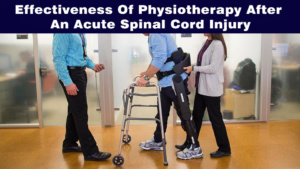Physiotherapy After an Acute Spinal Cord Injury

A client Z of age 65 years, endomorphic with a known case of DM, HTN, had a road traffic accident on the highway while traveling in a four-wheeler.
The client immediately after an accident felt some tenderness and pain at the neck region, thereafter slowly developed weakness of all four limbs followed by inability to move both upper limbs and lower limbs.
The patient was immediately rushed to the hospital, there they underwent MRI investigation and was diagnosed as a traumatic spinal cord injury with C6-C7 dislocation and fracture of C7 vertebrae with anterior wedging.
A spinal cord injury can be of traumatic (RTA, falls, violence, gunshot) or nontraumatic (TB, osteoporosis). It impacts the spinal cord, a bundle of nerves that are a part of CNS which acts as a mediator to transmit signals from the brain to the remaining part of the body.
This delicate spinal cord is protected by a bony structure called vertebral column which runs all over the back. Damage to this cord causes sensory, motor impairments, bladder, bowel dysfunction, respiratory and sexual dysfunction. Higher the injury the more severe the damage occurs.
Incomplete spinal cord injuries are becoming more prevalent than complete due to the advancement of research, medical management and early rehabilitation of the patients.
according to WHO, between 2,50,000 &5,00,000 people suffer from spinal cord injury throughout the year mostly within the age group of 20 to 39 yrs(RTA as the common cause)and in old age(osteoporosis,fall) whereas cervical injuries are the most common cause accounting for about 52.63% followed by thoracic injuries.
The client Z has undergone C5-C7, C7 laminectomy with bilateral c4, c5 lateral mass screw fixation, and bilateral C7, D1 pedicle screw fixation. After 16 days of hospital stay, the patient came to a progressive care rehabilitation center.
The patient had a complete neurologic physiotherapeutic assessment on the day of admission as an inpatient into progressive care. His status was as follows
- nonambulatory, bed-bound
- Grade 3 power over the right side of the body on MMT. Grade 0 over the left side of the body which shows no movement in the limbs of the left side.
- Impaired sensation below the level of the lesion
- Decreased muscle tone in bilateral upper and lower limbs
- Incontinence of bladder and bowel
- Dependent on bed mobility, transfers, dressing, bathing, feeding, self-care activities, FIM (FUNCTIONAL INDEPENDENCE MEASURE) scoring=1, which shows total assistance required to perform his activities of daily living.
At progressive care, we treated the patient twice a day with our specialized physiotherapeutic strategies like facilitatory techniques. The patient slowly gained a flicker of contraction on the very second day of admission in the left upper and lower limb.
The therapeutic techniques like PNF techniques, weight-bearing activities, use of tilt table for standing, and the patient gained movement in eliminating gravity over the left half of the body. We focused on muscle strengthening, balance retraining, and tone management, taught bed mobility training.
Thereby patient learned to roll over either side of the bed, transferred from bed to wheelchair, gained sitting balance, after that, we focused on balance retraining strategies in standing.
Over three months of intensive rehabilitation, the patient started to walk for a few steps with support, able to sense, control urination and defecation which was the primary goal of the patient to achieve after injury. After his initial goal of achievement, the patient got discharged as inpatient and used our services on an outpatient basis.
As an outpatient basis, we carefully integrated the advanced treatments, proven therapies, evidence-based research approaches to support patient recovery.
After 6 months of injury, the client started walking independently indoors, outdoors and was able to move out for family parties, social recreation without any support or discomfort.
On testing, FIM SCORE was 7 which show maximum independent in all activities with motor power 4+ on the left side of the body which was initially zero at the time of admission.
PREVENTION OF SPINAL CORD INJURIES
- By using a seat belt, safety restraints, helmet while driving.
- Never drive with consumption/influence of alcohol or drugs
- Follow the speed limit and traffic rules
- Necessary precautions for the elderly at home for preventing falls
- Effective emergency care is an essential component in reducing the incidence of spinal cord injuries.
Also, progressive care provides comprehensive care for patients not only with spinal cord injury but also for the persons with stroke, motor neuron disease, traumatic brain injury, etc
After the recovery of spinal cord injury, physiotherapy has to be continued at regular intervals to avoid deconditioning.
For more details contact
us on 📞9618906780
